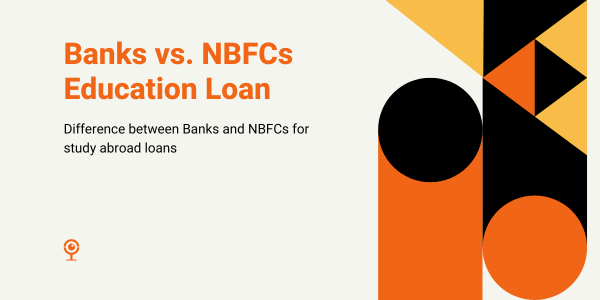Both Indian banks and Non-Banking Financial Companies (NBFCs) provide education loans to students for study abroad.
Banks, like (SBI)The State Bank of India, Punjab National Banks, and Bank of Baroda, are government-owned institutions.
Private Banks, like HDFC Bank, ICICI Bank, and Axis Bank, are privately owned institutions.
NBFCs(Non-Banking Financial Companies), are non-banking financial institutions, offer education loans without holding a banking license. NBFCs like HDFC Credila, Avanse, Auxilo, and InCred provides education loans to students.
Difference between Banks and NBFCs for study abroad loans
Banks:
- Eligibility criteria in Banks is complex
- Interest rates in Banks are lower
- Loan processing time in banks is 10-15 days
- Banks are less flexible in documentation
- Interest subsidies offered by the government can be availed
- In banks Tax benefits under Section 80e
- Banks provide concessions for women
- In Banks margin money is around 10-15% of the loan amount
- Loan processing fee is low
- In Banks secured loan limit varies with country and course
- Unsecured loan limit is INR 7.5 Lakhs
NBFCs:
- Eligibility criteria in NBFCs is simpler
- Interest rates in Banks are higher
- Loan processing time in NBFCs is 5 – 7 days after document submission
- NBFCs are more flexible in documentation
- In NBFCs no interest subsidy is applicable
- In NBFCs, no tax benefits
- In NBFCs, no concession for women
- In NBFCs, there is full coverage of study-related expenses
- Loan processing fee is high
- In NBFCs no secured loan limits
- No unsecured loan limits.
Public Banks: The State Bank Of India, Bank Of Baroda, Punjab National Bank, Union Bank Of India, Punjab & Sind Bank, Bank Of India, Bank Of Maharashtra
Private Banks: HDFC Bank, ICICI Bank, Axis Bank, IDBI Bank, IDBI Bank, Canara Bank, Kotak Mahindra Bank
NBFCs: Avanse, HDFC Credila, Auxilo, Icred.
- Banks are regulated by the Reserve Bank of India (RBI) and follow strict guidelines regarding interest rates, loan terms, and customer protection etc.On the other hand NBFCs are regulated by the RBI but are more flexible in determining interest rates and loan conditions.
- Public banks offer secured education loans up to INR 1.5 Cr or even higher with collateral. But only offer unsecured loans up to INR 7.5 Lakh, On the other hand NBFC offers education loans without collateral, which is a preferred choice.
- Banks have extensive documentation and verification process. They ask borrowers to submit various documents, such as proof of admission, academic records, income proof, collateral details (if applicable), and more. On the other hands, NBFCs often require fewer documents for loan approval. NBFCs are a suitable option for borrowers who wants quick education loan.
Factors to consider while choosing Banks and NBFCs for abroad education loan
- Public banks offer the most competitive rates starting from 8.15% whereas private banks offer slightly higher rates starting from 11.50%. NBFCs on the other hand offer interest rates starting from 11.75%.
- Banks offer higher loan amounts compared to NBFCs. Public and private banks offer loans upto 1.5 cr and more whereas NBFCs offer loans upto INR 80 – 90 Lakh.
- Banks take higher processing time as compared to NBFCs. Banks takes upto 15 working days but if you require a loan urgently (like in 5 days or so), then an NBFC will definitely be the preferred option
- Usually banks have low or even a policy of no processing fees whereas NBFCs charge a processing fee in the range of 1% to 2 % of the loan amount.
- In a bank, student don’t have to pay any interest while study. Loan repayment starts once student get a job or 6 months after completion of the course.On the other hand, in NBFCs, student has to pay a certain amount (full/partial interest) every month.


